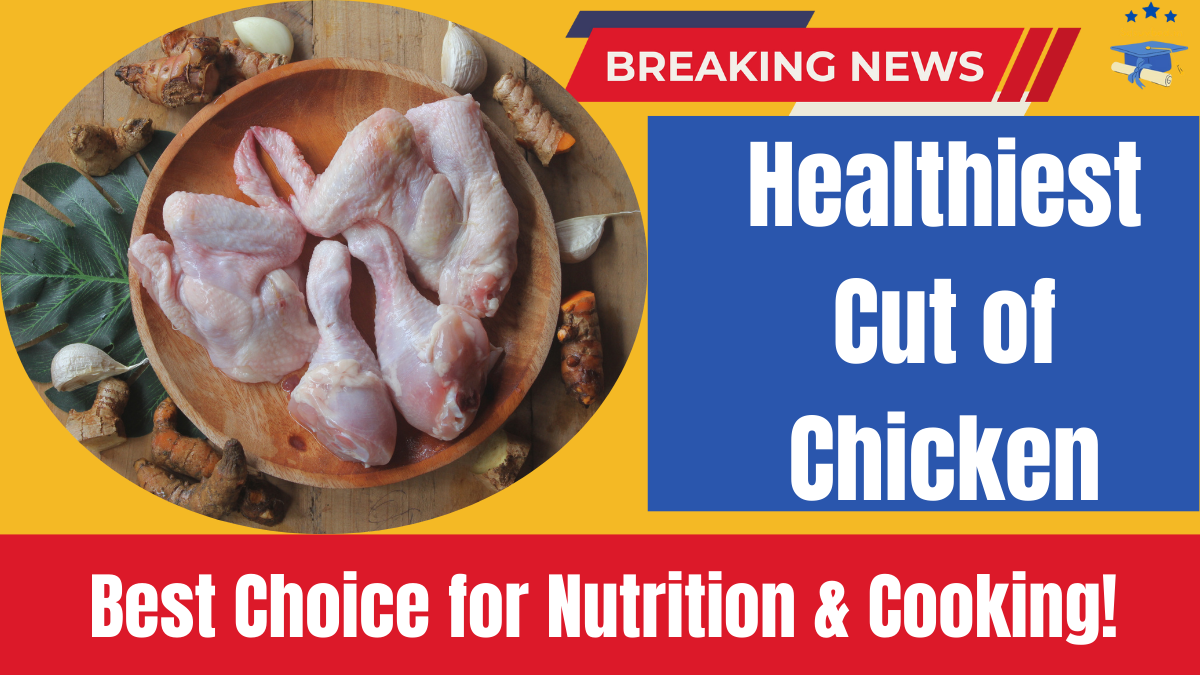Chicken is one of the most consumed proteins worldwide, appreciated for its affordability, versatility, and nutritional value. However, not all parts of the chicken are equally healthy. Some cuts offer higher protein and lower fat, while others provide more flavor and essential nutrients.
If you want to make the healthiest choice, it’s important to understand the differences between white and dark meat, the impact of skin and cooking methods, and the best ways to prepare chicken for maximum health benefits.

White Meat vs. Dark Meat: Which Is Healthier?
White meat comes from the chicken breast and wings, while dark meat includes the thighs, legs, and drumsticks. Each has distinct nutritional benefits.
White Meat: Lean and High in Protein
- Cuts: Chicken breast, tenderloin, wings
- Best for: Low-fat diets, muscle building, weight management
- Pros:
- Lower in fat and calories
- High in protein (great for muscle growth and recovery)
- Rich in calcium, phosphorus, and magnesium (supports bone health)
- Cons:
- Prone to dryness (needs careful cooking to retain moisture)
- Milder flavor compared to dark meat
Dark Meat: More Flavorful and Nutrient-Dense
- Cuts: Chicken thighs, drumsticks, legs
- Best for: Those needing extra iron, zinc, and healthy fats
- Pros:
- Higher in iron and zinc (essential for immunity and energy production)
- Juicier texture and richer flavor
- Contains heart-healthy omega-3 fatty acids
- Cons:
- Higher in fat and calories
- Slightly more sodium than white meat
Best Chicken Cuts for Health
Not all cuts are equal in terms of nutrition, taste, and ease of cooking. Here’s a breakdown of the healthiest options:
1. Chicken Breast – The Leanest Choice
- Calories (per 3.5 oz): 106
- Protein: 23g
- Fat: 2g
- Best Cooking Methods: Grilling, baking, steaming
- Why Choose It?
- Lowest in fat and cholesterol
- Ideal for weight loss and heart health
- Versatile and easy to cook
2. Chicken Tenderloin – Similar to Breast, but More Tender
- Calories (per 4 oz): 110
- Protein: 25g
- Fat: 1g
- Best Cooking Methods: Pan-searing, air frying, stir-frying
- Why Choose It?
- Easier to cook than breast
- Great for quick meals like salads and wraps
3. Chicken Thigh – A Balanced Choice
- Calories (per 3.5 oz): 144
- Protein: 19g
- Fat: 8g
- Best Cooking Methods: Roasting, slow cooking, air frying
- Why Choose It?
- More flavorful and moist than breast meat
- Contains omega-3 fatty acids and B vitamins
- Less expensive than chicken breast
4. Chicken Drumstick – Flavorful and Affordable
- Calories (per 3.5 oz): 149
- Protein: 18g
- Fat: 9g
- Best Cooking Methods: Baking, grilling, roasting
- Why Choose It?
- Rich in iron and zinc
- Budget-friendly and great for meal prep
What to Watch Out for When Eating Chicken
While chicken is a healthy protein, certain factors can increase its fat, calorie, and sodium content.
1. Chicken Skin – High in Fat
- Adds extra fat and calories to any cut
- Can be removed to reduce fat by up to 50%
- If you prefer eating the skin, opt for baking or air frying instead of deep-frying
2. Chicken Wings – Tasty but High in Calories
- Often fried and coated in sauces, increasing fat and sodium
- Healthier alternative: Bake or grill wings and remove the skin before eating
3. Processed Chicken (Deli Meat, Nuggets, Fast Food)
- Contains high sodium, preservatives, and unhealthy fats
- Linked to an increased risk of heart disease and cancer
- Healthier alternative: Choose fresh, unprocessed chicken and cook it at home
The Healthiest Ways to Cook Chicken
Cooking methods can significantly impact the nutritional value of chicken. To keep it healthy:
Best Cooking Methods:
- Grilling – Retains protein without adding extra fat
- Baking/Roasting – Keeps chicken moist without frying
- Steaming – No added fat, retains nutrients
- Pan-searing with minimal oil – Adds flavor without excess fat
- Air frying – Crispy texture with less oil
Methods to Limit:
- Deep frying – Adds unhealthy trans fats
- Breading – Increases calories and reduces nutritional value
- Heavy sauces – Adds excess sugar and sodium
Pro Tip: Enhance flavor without extra calories by using herbs, lemon juice, and spice rubs instead of butter or creamy sauces.
Final Verdict: What’s the Healthiest Part of the Chicken?
The best chicken cut depends on your dietary goals:
- For weight loss & heart health → Chicken breast or tenderloin
- For flavor & extra nutrients → Chicken thigh
- For affordability & meal prep → Chicken drumstick
While white meat is lower in fat and calories, dark meat contains more essential nutrients like iron and zinc. Choosing the right cooking method and removing excess skin or fat can make any part of the chicken a healthy choice.
By selecting the right cuts, cooking them properly, and pairing them with vegetables and whole grains, chicken can be a nutrient-dense addition to any healthy diet.
Click here to know more.
A passionate content writer specializing in creating engaging, SEO-optimized content. With expertise in blogs, web copy, and storytelling, I craft words that connect with audiences and deliver results.
